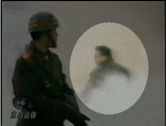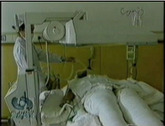Five years ago this week, a group of five Chinese appeared on television screens across the world in a shocking apparent suicide attempt. The news reports said the five set themselves on fire in a stunt they thought would lead them to heaven. The storyline, as told by state-run media in China, where Falun Gong has been the target of a well-documented persecution, has tried to link the incident with Falun Gong. It has become the number one supporting argument for the Chinese communist regime that Falun Gong is dangerous and the crackdown against it is thus justified.
Five years later, independent investigation has shown the self-immolation to be a deadly hoax. Yet still, few have heard the real story.
The Backdrop
It was January 2001, and the regime in China was struggling to keep its then-18-month-old persecution against the spiritual practice Falun Gong afloat. When then-chairman Jiang Zemin first declared the practice illegal, it was said he announced it would be gone in three months. The full weight of the military, secret police, and state-run media had born down on it. And yet, 18 months on, not only had Falun Gong not been crushed, but from the grassroots to the highest echelons in the government, voices of dissent were calling for an end to the persecution campaign.
"To be honest, the people who were in charge at the local level didn't like to do this [kind of persecuting]," Hao Fengjun told The Epoch Times in an interview in June 2005.
Hao is a former officer in China's 6-10 office, a department set up to carry out the persecution of Falun Gong. He defected to Australia in February 2005 and approached The Epoch Times with his story last summer.
He described the difficulty the communist party had in enforcing the crackdown on Falun Gong in local areas. "The police there lived in close proximity to ordinary people. For example, maybe you would live right next door to me, and we would see each other all the time […] If people like that don't do anything corrupt or violate the law, could you have the heart to arrest them?"
On January 11th, 2001, a New York Times article titled "China Attacks the Falun Gong in New Public Relations Effort" detailed how the regime was stepping up the propaganda war on Falun Gong with increased vigor, an effort to shore up more public support for the campaign.
Not two weeks later, on January 23rd, Xinhua News Agency—the self-described mouthpiece of the Chinese regime—announced that five people had set themselves on fire on Tiananmen Square. Xinhua immediately identified the five as Falun Gong practitioners and claimed they were led by Falun Gong to burn themselves in a religious suicide attempt. This self-immolation retroactively proved to the world that Falun Gong was an "evil cult" that deserved to be wiped out.
Though the state-run media initially reported five people had been involved in the self-immolation, it later changed the number to seven—including a 12-year-old girl, Liu Siying, whose mother Liu Chunling was reportedly burned to death in the incident.
Chinese media circulated the news with unusual speed, broadcasting it almost daily for months on end. Xinhua sent out an English-language news release blaming Falun Gong for the incident only two hours after it occurred, a sharp contrast to the usually sluggish pace of Chinese state-media. Foreign media parroted the story, despite being unable to independently confirm its veracity and then being denied access to the victims. Only China's state-run media were allowed to interview the self-immolators.
The regime had struck its biggest propaganda victory in its war on Falun Gong.
Overnight, the population of China had gone from being largely ambivalent—even sympathetic—toward Falun Gong, to being hostile. Fleeting sympathies toward the persecuted practice were quickly replaced with anger and support for the regime's campaign to eliminate it.
More Chinese began to turn in their coworkers, neighbours, and even family who practised Falun Gong, believing the group was truly dangerous. Reportedly, mobs of angry citizens even actively helped police track down and harass Falun Gong adherents. Inside the Communist Party, support for the crackdown solidified and local authorities had new incentive to follow the party line.
The recorded number of Falun Gong adherents tortured to death in the first 18 months of the regime's violent crackdown would nearly triple in the next 12.
"Before the self-immolation, I was indifferent about Falun Gong," said Li Xiang, 25, a Chinese graduate student in Toronto who was in Beijing at the time. She asked to be identified by this alias as she still plans to return to China.
"I thought Falun Gong was really dangerous and evil," Li said. "I was struck by the young music student who they said burned herself. She was beautiful. I still remember her name."
Amidst the media onslaught, not a single television, radio, or newspaper report told Falun Gong's side of the story. Chinese were unable to pick up a Falun Gong book at the library and learn that killing and violence were against the basic tenets of the practice as authorities had already rounded up and destroyed millions of books. Websites were blocked and dissenters were arrested. Chinese were only allowed the official account of the event.
Perhaps more importantly for the regime, the incident cooled pressure from foreign governments and media, who had taken notice of the repression. Television screens and newspapers around the world were instead awash with images of the alleged self-immolators along with lines scripted by Xinhua, describing how Falun Gong had led the group to burn themselves.
 |
| (NTDTV's False Fire video, showing footage from China Central Television) |
But considering the impact the incident has had in helping to fuel the torture and murder of thousands of Falun Gong practitioners, Western media would have been well-advised to take a closer look at the glaring inconsistencies in the Chinese state-run media's plot.
Holes in the Story
Immediately after word of the self-immolation broke, Falun Gong groups overseas raised doubts over whether the self-immolators were real adherents of the practice, going so far as to suggest that the incident was a hoax. They pointed out that all of Falun Gong's protests against the regime's persecution had been peaceful up to that point, and noted that Falun Gong strictly prohibits killing or suicide.
 |
| (NTDTV's False Fire video, showing footage from China Central Television) |
The identities of the self-immolators were further called into question when the Washington Post ran a story on Liu Chunling—the woman who had died in the fire—and her young daughter. A Post reporter travelled to Liu's hometown of Kaifeng only to conclude that "none ever saw her practice Falun Gong."
Meanwhile, the reported condition of the now-orphaned 12-year-old Liu Siying had those in medical circles raising their eyebrows. An interview aired by China Central Television showed the girl, completely covered in bandages, singing for a CCTV reporter some four days after she was said to have undergone a tracheotomy.
"I've never seen such a kind of patient in my all of my practice," Yu Jianmei, the former Head Surgeon at Beijing Xuanwu Hospital, told a U.S.-based television station after the incident. "After having a tracheotomy, such a seriously ill patient could still project a clear voice and even could sing."
"Besides," continued a suspicious Yu, "patients with large areas of burns should have their burns exposed…because if you wrap the burns too closely, it would be very hard for nurses to clean the burns and apply treatments. The burns would also be very prone to infection."
Despite the young Liu's supposed miraculous initial recovery, months later it seems her condition suddenly plummeted and authorities reported that she died.
By this time, analysts of the state-run media footage of the incident, were suggesting her mother's death was not what it was originally made out to be. Slow motion analysis of the tape reveals that Liu Chunling was killed not from flames, but from a fatal blow to the head, delivered by a man in a military overcoat.
But as is often the case in China, getting to the bottom of the story was made difficult for foreign reporters. At first, the regime allowed only state-run media access to the self-immolation victims. Later, all the victims had either died (in some cases mysteriously) or had been sealed off from media completely.
There was one exception, however. On the first anniversary of the self-immolation in 2002, one victim, Wang Jindong, was brought out to speak with media in a tightly choreographed event. The man, his face utterly deformed by burns, explained how Falun Gong had led him to make the dramatic suicide attempt.
One year later, however, researchers at National Taiwan University reviewing the tape of Wang's 2002 interviews with the press, and Wang's hollerings in Tiananmen Square in 2001, concluded that the two could not have been the same person. The whereabouts of the real Wang, and of the other surviving self-immolators, are unknown.
Time only allowed the analysts to find more inconsistencies. For example, policemen on Tiananmen Square were reportedly on scene with 25 pieces of fire-fighting equipment within seconds of the first self-immolator going up in flames. But police on Tiananmen Square do not usually carry fire extinguishers. The closest pieces of fire-fighting equipment were no less than a 20-minute round-trip away.
The Fight For The Truth
As evidence stockpiled pointing to the self-immolation as being a staged event, Falun Gong adherents in China became determined to get the news out about a story that had so badly tarnished their reputations. And the communist regime became adamant about stopping them.
In March 2002, practitioners or supporters of Falun Gong in northeast China's Changchun City tapped into television airwaves to broadcast a deconstruction of the state media's own footage of self-immolations. The authorities reacted decisively. Multiple biographies of then-leader Jiang Zemin say he personally responded to the incident.
A state of martial-law was effected in Changchun, checkpoints were set up, and "scores" of Falun Gong practitioners were arrested, according to an Amnesty International Urgent Action notice published at the time, warning that those detained were at risk of torture.
Adherents say as many as 5000 were arrested, most of them tortured, and a number of them even to death. One of the prominent men named in the Amnesty notice, Liu Chengjun, was imprisoned and died of torture the day after Christmas 2003.
The reactions of Chinese people who have seen the self-immolation deconstruction makes clear why the Communist authorities are so anxious.
The young student Li Xiang has seen the video while in Canada.
"I was shocked," she said. "I cannot imagine a government of such a big country could tell such lies without feeling any embarrassment. It makes me question everything I was told by them."
To view the deconstruction of the incident video and see other materials, please visit www.falsefire.info
* * *
You are welcome to print and circulate all articles published on Clearharmony and their content, but please quote the source.












 more ...
more ...